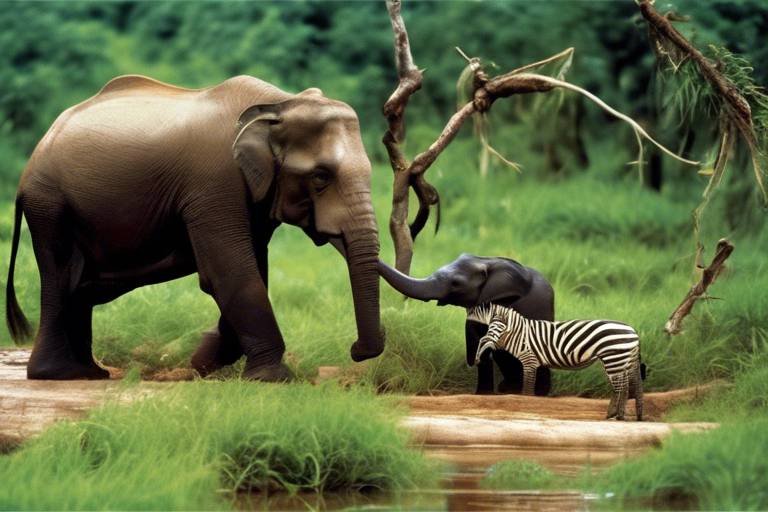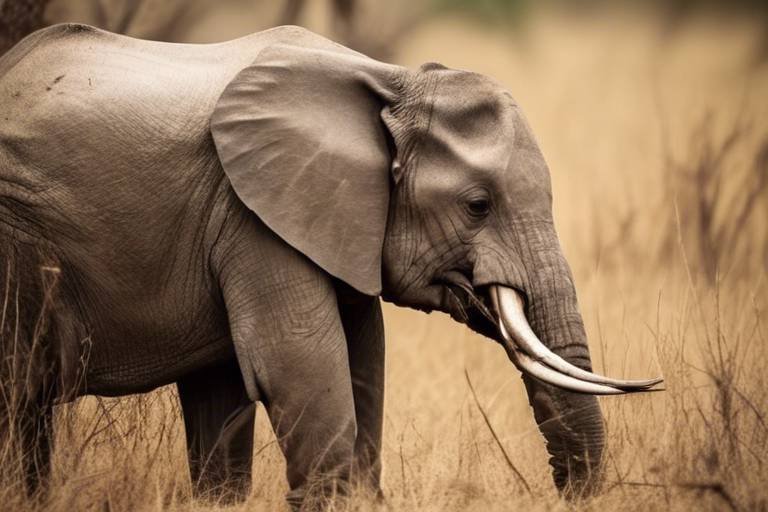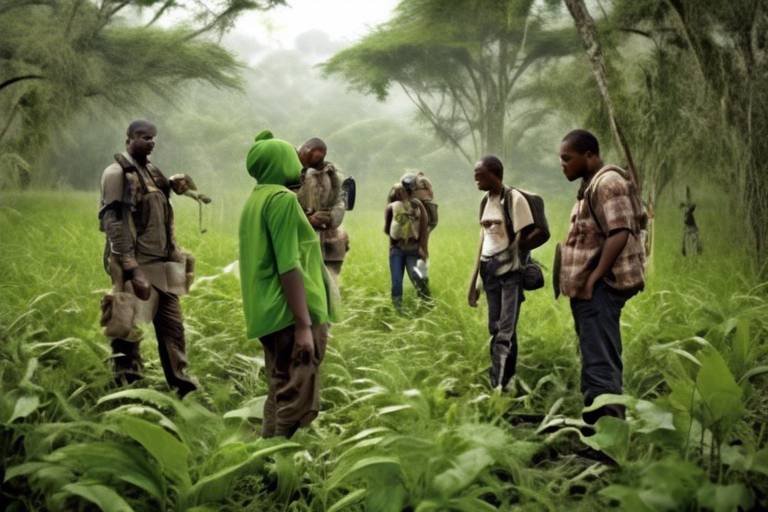Conservation Crossroads: Biodiversity vs Infrastructure Development
In today's rapidly evolving world, we find ourselves at a critical junction where the paths of biodiversity conservation and infrastructure development intersect. This intersection is not just a mere crossing of roads; it symbolizes the ongoing struggle between preserving our planet's precious ecosystems and meeting the growing demands of human progress. As urban areas expand and infrastructure projects proliferate, the question arises: can we truly have it all? Can we build the roads, bridges, and buildings we need while also safeguarding the rich tapestry of life that surrounds us?
The reality is that biodiversity is not merely an environmental concern; it is the foundation upon which our very existence rests. From the air we breathe to the food we eat, biodiversity plays a crucial role in maintaining the balance of our ecosystems. Yet, as we push forward with development, we often overlook the profound impacts that these projects can have on our natural world. Each time a new highway is paved or a shopping center is erected, we risk fragmenting habitats, endangering species, and disrupting the delicate processes that sustain life.
However, this is not a tale of doom and gloom. There is an opportunity to rethink our approach. By understanding the intricate relationship between biodiversity and infrastructure, we can devise innovative solutions that allow us to move forward without sacrificing our environmental heritage. Imagine a world where wildlife corridors seamlessly connect fragmented habitats, allowing animals to roam freely while urban development flourishes. Picture cities designed with green spaces that not only beautify the landscape but also support local flora and fauna.
Ultimately, the challenge lies in striking a balance. It requires a collaborative effort among policymakers, developers, and communities to ensure that our development goals align with the principles of sustainability. We must ask ourselves: what kind of legacy do we want to leave for future generations? Will they inherit a world rich in biodiversity, or will they be left with concrete jungles devoid of life?
In the following sections, we will delve deeper into the importance of biodiversity, the trends in infrastructure development, and the strategies we can employ to harmonize these two seemingly opposing forces. Through case studies and real-world examples, we will explore how we can navigate this conservation crossroads and emerge with solutions that honor both nature and progress.

The Importance of Biodiversity
Biodiversity is more than just a buzzword; it's the foundation of life on Earth. Imagine a world where every creature, plant, and microorganism plays a role in a grand symphony of existence. This intricate web of life not only supports ecosystem functionality but also enhances our quality of life in ways we often take for granted. The significance of biodiversity extends far beyond aesthetics; it is crucial for maintaining the balance of nature, providing essential resources, and ensuring the health of our planet.
First and foremost, biodiversity contributes to ecosystem services, which are the benefits that humans derive from nature. These services include:
- Pollination: Many crops depend on pollinators like bees and butterflies. Without them, our food supply would dwindle.
- Water purification: Wetlands and forests filter pollutants, ensuring clean water for drinking and agriculture.
- Climate regulation: Diverse ecosystems help regulate the climate by absorbing carbon dioxide and releasing oxygen.
Moreover, biodiversity is a treasure trove of genetic resources. From the crops we eat to the medicines we rely on, genetic diversity within species is essential for agricultural resilience and medical breakthroughs. Think of it this way: just as a diverse team brings different perspectives to a problem, a diverse ecosystem has the tools it needs to adapt to changes and challenges.
However, the importance of biodiversity goes beyond mere resources. It contributes to cultural and spiritual values. Many communities around the world have deep connections to their natural environments, which shape their identities and traditions. Losing biodiversity means losing these cultural ties, which can lead to a diminished sense of community and belonging.
In the face of rapid infrastructure development, understanding the importance of biodiversity is more critical than ever. As we pave roads and build skyscrapers, we risk fragmenting habitats and endangering species that are vital for our survival. The challenge lies in recognizing that while we need infrastructure for economic growth, we cannot afford to overlook the ecological health that sustains us.
In conclusion, biodiversity is not just a luxury; it is a necessity. It supports ecosystem functionality, provides invaluable resources, and enriches our cultural fabric. As we navigate the crossroads of development and conservation, let’s remember that protecting biodiversity is essential for a sustainable future. After all, a healthy planet means a healthier humanity.
Q: Why is biodiversity important for human health?
A: Biodiversity contributes to our health by providing medicinal resources, clean air, and water, and by supporting food systems that nourish us.
Q: How does infrastructure development threaten biodiversity?
A: Infrastructure development can lead to habitat destruction, fragmentation, and pollution, which negatively impact wildlife and ecosystems.
Q: What can individuals do to help protect biodiversity?
A: Individuals can support conservation efforts, practice sustainable living, and advocate for policies that protect natural habitats.

Infrastructure Development Trends
Infrastructure development is a driving force behind economic growth and societal advancement. In our rapidly evolving world, the demand for better roads, bridges, public transportation, and housing has never been greater. As cities expand and populations grow, the need for robust infrastructure becomes crucial. However, this expansion often comes at a significant cost to our natural environment.
With the acceleration of urbanization, we are witnessing a trend towards the construction of mega-projects that promise to enhance connectivity and improve living standards. These projects can range from high-speed rail systems to sprawling highways and even large-scale housing developments. While these developments can create jobs and stimulate local economies, they also pose serious risks to biodiversity. The challenge lies in navigating these competing interests.
One of the most pressing concerns is the impact of infrastructure on natural habitats. As construction crews break ground, they often encroach on ecosystems that are home to countless species. The result? Habitat fragmentation, where large, continuous habitats are split into smaller, isolated patches. This phenomenon can lead to a decline in wildlife populations, as species struggle to find food, mates, and shelter. To illustrate this point, consider the following table that highlights some of the key trends in infrastructure development and their associated impacts on biodiversity:
| Infrastructure Type | Impact on Biodiversity |
|---|---|
| Road Construction | Increased vehicle collisions with wildlife, habitat fragmentation |
| Urban Expansion | Loss of green spaces, increased pollution, habitat loss |
| Hydroelectric Dams | Altered water flow, fish population decline, habitat destruction |
| Mining Operations | Land degradation, water contamination, loss of flora and fauna |
As we look at these trends, it becomes evident that the need for careful planning and consideration of environmental impacts is more important than ever. Infrastructure projects should not only focus on immediate human benefits but also on long-term ecological sustainability. This means integrating sustainable practices into the planning and execution phases of development. For instance, using eco-friendly materials, implementing green spaces, and ensuring that wildlife corridors are established can significantly mitigate the negative impacts of infrastructure on biodiversity.
Moreover, the conversation around infrastructure development is evolving. Stakeholders, including governments, private sectors, and local communities, are increasingly recognizing the importance of environmental stewardship. This shift is encouraging more holistic approaches to planning that take into account the intricate web of life that exists within our ecosystems.
In conclusion, while infrastructure development is essential for progress, it must be pursued with a conscious effort to protect our planet's biodiversity. By fostering a collaborative dialogue among all stakeholders and prioritizing sustainable practices, we can pave the way for a future where both human advancement and ecological integrity coexist harmoniously.
- What is biodiversity and why is it important? Biodiversity refers to the variety of life on Earth, including the different species, genetic variations, and ecosystems. It is crucial for ecosystem functionality, providing resources for humans and maintaining ecological balance.
- How does infrastructure development affect biodiversity? Infrastructure development can lead to habitat destruction, fragmentation, and pollution, which can threaten wildlife populations and disrupt ecological processes.
- What are some strategies to mitigate the impact of infrastructure on ecosystems? Strategies include creating wildlife corridors, conducting environmental impact assessments, and restoring habitats to ensure that ecological health is prioritized during development.
- How can communities get involved in conservation efforts? Community involvement can take many forms, such as participating in local conservation programs, advocating for sustainable practices, and engaging in dialogue with policymakers about development projects.

Impact on Ecosystems
The impact of infrastructure development on ecosystems is profound and often devastating. When we think about the roads we travel on, the buildings we work in, and the bridges we cross, we might not immediately consider the hidden cost to our natural world. Every time a new highway is constructed or a shopping mall is built, we are encroaching on habitats that are home to countless species. This disruption can lead to significant consequences for biodiversity, altering the delicate balance of ecosystems that have evolved over millennia.
One of the most alarming effects of infrastructure development is habitat fragmentation. Imagine a vibrant forest that serves as a home to various wildlife. When a road slices through this forest, it not only divides the habitat but also isolates populations of animals, making it difficult for them to find mates, food, and shelter. This isolation can lead to a decline in genetic diversity, which is crucial for the survival of species. Furthermore, fragmented habitats are more susceptible to invasive species, which can outcompete native species for resources.
Additionally, infrastructure projects can lead to the loss of species. As natural habitats are destroyed or altered, many species find it challenging to adapt to the changes. For instance, wetland areas that are drained for construction can lead to the disappearance of aquatic species that rely on these environments for survival. The extinction of just one species can have a ripple effect throughout the ecosystem, disrupting food chains and leading to further losses.
Another critical aspect to consider is the alteration of ecological processes. Infrastructure can change water flow patterns, affect soil composition, and alter temperature regimes. For example, the construction of roads can lead to increased runoff and erosion, which can degrade water quality in nearby rivers and streams. This degradation can affect not only aquatic life but also the animals that depend on these water sources for survival.
To illustrate the impact of infrastructure on ecosystems, let’s look at a few key statistics:
| Impact Type | Example | Consequences |
|---|---|---|
| Habitat Fragmentation | Road construction through forests | Isolation of wildlife populations |
| Species Loss | Wetland drainage for urban development | Decline of aquatic species |
| Altered Ecological Processes | Construction of dams | Disruption of fish migration |
In conclusion, the impact of infrastructure development on ecosystems is a complex issue that requires careful consideration. As we continue to build and expand our urban landscapes, it is essential to recognize the value of biodiversity and the ecological services that healthy ecosystems provide. By understanding these impacts, we can better advocate for sustainable development practices that prioritize the preservation of our natural world.
- What is habitat fragmentation? Habitat fragmentation occurs when large habitats are divided into smaller, isolated sections, making it difficult for wildlife to thrive.
- How does infrastructure development affect species diversity? Infrastructure development can lead to habitat loss, which in turn reduces species diversity by isolating populations and making it harder for them to survive.
- What are some ways to mitigate the impacts of infrastructure on ecosystems? Mitigation strategies include creating wildlife corridors, conducting environmental impact assessments, and restoring habitats affected by development.

Case Studies of Ecosystem Disruption
When we talk about the impact of infrastructure development on biodiversity, it's essential to look at real-world examples that illustrate the challenges we face. One such case is the construction of the Trans-Amazonian Highway in Brazil. This ambitious project aimed to connect the country's remote regions to urban centers, but it has resulted in significant ecological disruptions. The highway has led to widespread deforestation, fragmenting habitats and threatening countless species, including the iconic jaguar and various endemic plants. The environmental cost of this infrastructure development has been staggering, with estimates suggesting that over 20% of the Amazon rainforest has been lost since the highway's inception.
Another compelling case study is the California High-Speed Rail project. While this initiative promises to revolutionize transportation and reduce carbon emissions, it has faced criticism for its potential impacts on local ecosystems. The construction process poses risks to several endangered species, such as the California tiger salamander and the San Joaquin kit fox. Environmentalists argue that the project could lead to habitat loss and fragmentation, which could push these species closer to extinction. This situation raises a crucial question: Can we truly prioritize human advancement without jeopardizing the very ecosystems that sustain us?
In Australia, the Western Sydney Airport project serves as another example of infrastructure development clashing with biodiversity. The site is home to several threatened species, including the Eastern Dwarf Tree Frog and the Cumberland Plain Woodland ecosystem. Despite the economic benefits touted by proponents, local conservationists have raised alarms about the irreversible damage that could occur. The Australian government has promised to implement mitigation strategies, but many remain skeptical about their effectiveness in protecting these vulnerable species.
These case studies reveal a pattern: infrastructure development often comes at a steep ecological price. However, they also highlight the potential for change. For instance, in the United Kingdom, the High Speed 2 (HS2) rail project has incorporated extensive environmental assessments and mitigation measures, including the creation of wildlife corridors and habitat restoration efforts. Such initiatives demonstrate that it is possible to pursue infrastructure projects while still prioritizing biodiversity. The key takeaway here is that with careful planning and a commitment to sustainability, we can find pathways that allow for both development and ecological preservation.
As we examine these case studies, it becomes clear that the stakes are high. The choices we make today regarding infrastructure development will have lasting impacts on our planet's biodiversity. It's not just about building roads and bridges; it's about ensuring a future where both human and ecological needs are met. By learning from these examples, we can strive for a more harmonious coexistence between progress and conservation.
- What are the primary impacts of infrastructure development on biodiversity? Infrastructure development can lead to habitat destruction, fragmentation, and pollution, which threaten various species and disrupt ecosystems.
- How can we mitigate the effects of infrastructure projects on ecosystems? Strategies such as creating wildlife corridors, conducting environmental impact assessments, and restoring habitats can help minimize negative impacts.
- Are there successful examples of balancing development and conservation? Yes, projects like HS2 in the UK have implemented effective mitigation measures to protect biodiversity while pursuing infrastructure goals.
- What role do local communities play in conservation efforts? Local communities can provide valuable insights and support for conservation strategies, ensuring that both development and ecological integrity are prioritized.

Mitigation Strategies
When it comes to the clash between biodiversity conservation and infrastructure development, the need for effective mitigation strategies becomes paramount. These strategies serve as a bridge, allowing us to pursue progress while safeguarding our planet's rich tapestry of life. One of the most promising approaches is the establishment of wildlife corridors. These corridors act like highways for animals, enabling them to traverse landscapes that would otherwise be fragmented by roads, buildings, and other human-made structures. Imagine a lush green pathway cutting through a concrete jungle, allowing deer, foxes, and countless other species to move freely and safely—this is the essence of wildlife corridors.
Another vital strategy is habitat restoration. This involves returning degraded ecosystems to their natural state, essentially giving nature a second chance. Think of it as a gardener tending to a wilting plant, nurturing it back to health. By restoring habitats that have been damaged by previous developments, we can help revive populations of endangered species and ensure that ecosystems remain resilient. For instance, replanting native vegetation in areas where invasive species have taken over can dramatically improve local biodiversity.
Moreover, conducting thorough environmental impact assessments (EIAs) before embarking on any infrastructure project can significantly mitigate negative effects on biodiversity. These assessments evaluate the potential impacts of a project on the environment, allowing developers to make informed decisions. They can identify critical habitats and species that need protection, ensuring that the planning process incorporates biodiversity considerations from the outset.
To further illustrate the importance of these strategies, let's take a look at a simple comparison of their effectiveness:
| Mitigation Strategy | Benefits | Challenges |
|---|---|---|
| Wildlife Corridors | Enhances animal movement; reduces roadkill | Requires significant land and planning |
| Habitat Restoration | Revives ecosystems; supports biodiversity | Time-consuming and resource-intensive |
| Environmental Impact Assessments | Informs decision-making; identifies risks | Can be overlooked or poorly executed |
Incorporating these strategies into the planning and execution of infrastructure projects is not merely an option; it is a necessity for a sustainable future. By prioritizing biodiversity, we are not just protecting wildlife; we are ensuring the health and stability of our ecosystems, which ultimately benefits humanity. After all, a thriving natural world supports clean air, water, and food—essentials for our survival.
- What are wildlife corridors? Wildlife corridors are designated areas that connect fragmented habitats, allowing animals to safely migrate and access resources.
- How does habitat restoration work? Habitat restoration involves rehabilitating damaged ecosystems through activities like replanting native species and removing invasive ones.
- What is an environmental impact assessment? An EIA is a process that evaluates the potential environmental effects of a proposed project, helping to mitigate negative impacts on biodiversity.

Balancing Development and Conservation
In today's fast-paced world, the clash between development and conservation is more pronounced than ever. As we strive to build roads, bridges, and urban centers that foster economic growth, we must also remember the delicate fabric of our ecosystems that supports life on Earth. Balancing these two seemingly opposing forces is not just a matter of policy; it's a necessity for our survival and the health of our planet.
Imagine a beautiful forest teeming with life—a vibrant ecosystem where every creature, from the tiniest insect to the majestic deer, plays a role in maintaining the balance of nature. Now, picture that same forest being replaced by a sprawling shopping complex. The impact of such development is profound and often irreversible. However, it doesn't have to be this way. By integrating sustainable practices into our planning processes, we can create a harmonious coexistence between infrastructure and nature.
One of the most effective ways to achieve this balance is through the incorporation of green infrastructure principles. This approach emphasizes the use of natural processes to manage water, reduce heat, and enhance biodiversity. For instance, implementing permeable pavements, green roofs, and rain gardens can significantly reduce runoff and improve water quality while providing habitats for various species. By prioritizing these eco-friendly designs, we can ensure that our urban landscapes contribute positively to the environment rather than detract from it.
Moreover, community involvement is crucial in this balancing act. Engaging local stakeholders in the decision-making process allows for a more comprehensive understanding of the ecological and social ramifications of development projects. When communities are empowered to voice their concerns and preferences, the outcomes tend to be more sustainable and equitable. This participatory approach fosters a sense of ownership and responsibility towards the local environment, leading to innovative solutions that benefit both development and conservation.
To further illustrate the importance of this balance, consider the following table that outlines key strategies for integrating development and conservation:
| Strategy | Description |
|---|---|
| Wildlife Corridors | Designate pathways that allow wildlife to safely cross developed areas, reducing habitat fragmentation. |
| Environmental Impact Assessments | Conduct thorough assessments before project initiation to understand potential ecological consequences. |
| Community-Based Conservation | Involve local populations in conservation efforts, ensuring their needs and knowledge are integrated into planning. |
Ultimately, the goal is to create a future where development does not come at the expense of our planet's precious biodiversity. By embracing sustainable practices, engaging communities, and implementing robust policies, we can pave the way for a brighter, greener future. It's about finding that sweet spot where human progress and ecological integrity can thrive together. After all, a thriving planet is the best foundation for a prosperous society.
- What is biodiversity, and why is it important? Biodiversity refers to the variety of life on Earth, including the different species, ecosystems, and genetic diversity. It is crucial for ecosystem functionality, providing resources and services that humans rely on.
- How can infrastructure development negatively impact biodiversity? Infrastructure development can lead to habitat destruction, fragmentation, and pollution, which can threaten wildlife and disrupt ecological processes.
- What are some examples of sustainable infrastructure? Examples include green roofs, permeable pavements, and the creation of wildlife corridors to facilitate safe animal movement across developed areas.
- How can communities get involved in conservation efforts? Communities can participate by voicing their concerns during planning processes, engaging in local conservation programs, and advocating for policies that protect biodiversity.

Policy and Regulation
In the intricate dance between biodiversity conservation and infrastructure development, policies and regulations act as the guiding stars. They are essential in ensuring that while we pave roads and erect buildings, we also safeguard the vibrant ecosystems that sustain life on our planet. The challenge lies in crafting regulations that are robust enough to protect our natural heritage while still allowing for necessary development. This balancing act requires a deep understanding of both the environmental and socio-economic landscapes.
At the heart of effective policy-making is the need for comprehensive frameworks that address the various dimensions of biodiversity. These frameworks must not only set limits on what can be developed and where but also encourage sustainable practices that promote ecological health. For instance, policies can mandate the use of environmental impact assessments (EIAs) before any major infrastructure project begins. These assessments help identify potential ecological risks and suggest ways to mitigate them, ensuring that development does not come at the expense of our natural resources.
Moreover, international agreements play a pivotal role in shaping national policies. Treaties such as the Convention on Biological Diversity (CBD) set forth binding commitments for countries to protect their biodiversity. These agreements can influence local regulations, pushing governments to prioritize conservation in their development plans. However, the effectiveness of these international frameworks often hinges on local implementation and community engagement.
Local regulations are equally important in the conservation equation. They can provide a more tailored approach that considers the unique ecological and cultural contexts of a region. For instance, a community might establish protected areas that not only preserve critical habitats but also enhance local tourism and recreation opportunities. When communities are involved in the decision-making process, the outcomes are often more successful and sustainable. This collaborative approach fosters a sense of ownership and responsibility towards local ecosystems.
In summary, effective policy and regulation are crucial for navigating the complexities of biodiversity conservation and infrastructure development. By integrating strong environmental standards, engaging local communities, and adhering to international commitments, we can work towards a future where development and conservation go hand in hand. It’s not just about paving the way for progress; it’s about ensuring that the roads we build lead to a sustainable future for all living beings.
- What is the role of international agreements in biodiversity conservation?
International agreements set standards and commitments that countries must follow to protect biodiversity, influencing national policies and infrastructure projects. - How can local regulations help in biodiversity conservation?
Local regulations can address specific ecological concerns and involve community input, leading to more effective and tailored conservation strategies. - What are environmental impact assessments?
Environmental impact assessments (EIAs) are evaluations conducted to identify potential environmental risks of proposed infrastructure projects and suggest mitigation strategies. - Why is community involvement important in conservation efforts?
Community involvement fosters a sense of ownership and responsibility, leading to more effective conservation strategies that align with local needs and values.

International Agreements
International agreements play a pivotal role in the realm of biodiversity conservation. These agreements are not just mere documents; they are the backbone of global efforts aimed at preserving our planet's rich tapestry of life. Imagine trying to navigate a ship through stormy seas without a compass—this is what countries face when they lack a unified approach to environmental issues. These agreements set essential standards and commitments that nations must adhere to, creating a framework for cooperation and action.
One of the most significant agreements in this context is the Convention on Biological Diversity (CBD), which was established in 1992. The CBD aims to conserve biodiversity, promote sustainable use of its components, and ensure fair sharing of benefits arising from genetic resources. Countries that are party to this agreement commit to implementing national strategies that align with its goals. But what does this mean in practice? It means that nations are encouraged to assess their biodiversity, identify threats, and take action to mitigate these threats through effective policies and regulations.
Another key international agreement is the Paris Agreement, which, while primarily focused on climate change, has significant implications for biodiversity. The interconnectedness of climate change and biodiversity loss cannot be overstated. Rising temperatures and extreme weather events can devastate ecosystems, leading to species extinction and habitat loss. The Paris Agreement encourages countries to set ambitious targets for reducing greenhouse gas emissions, which indirectly supports biodiversity conservation efforts. By addressing climate change, we can help protect the habitats that countless species depend on.
Furthermore, the Ramsar Convention on Wetlands is another vital international treaty that emphasizes the importance of wetland ecosystems. Wetlands are biodiversity hotspots, providing habitat for a myriad of species and playing a crucial role in water purification and flood control. The Ramsar Convention promotes the sustainable management and conservation of these critical areas, encouraging countries to designate wetlands of international importance and implement measures to protect them.
To illustrate the impact of these agreements, consider the following table, which highlights some key international agreements and their primary focus areas:
| Agreement | Year Established | Main Focus |
|---|---|---|
| Convention on Biological Diversity (CBD) | 1992 | Conservation of biodiversity, sustainable use, and fair sharing of resources |
| Paris Agreement | 2015 | Climate change mitigation and adaptation |
| Ramsar Convention on Wetlands | 1971 | Conservation and sustainable use of wetlands |
While these international agreements lay the groundwork for biodiversity conservation, their effectiveness hinges on national implementation. This is where local regulations come into play. Countries must translate these global commitments into actionable local policies. For instance, a country that signs the CBD needs to develop a national biodiversity strategy that addresses its unique ecological challenges. When local governments and communities are engaged in this process, the result is often more effective and tailored conservation strategies that resonate with the specific needs of the ecosystem and the people living within it.
In conclusion, international agreements are crucial in the fight for biodiversity conservation. They create a shared vision and responsibility among nations, emphasizing that the preservation of our planet's biodiversity is not just a local issue, but a global imperative. As we move forward, it's essential to strengthen these agreements and ensure that they translate into meaningful actions on the ground, fostering a harmonious balance between development and conservation.
- What is the Convention on Biological Diversity (CBD)?
The CBD is an international treaty aimed at conserving biodiversity, promoting sustainable use of its components, and ensuring fair sharing of benefits arising from genetic resources. - How does climate change impact biodiversity?
Climate change leads to habitat loss, species extinction, and alters ecological processes, making it crucial to address both climate change and biodiversity conservation simultaneously. - What role do local regulations play in biodiversity conservation?
Local regulations are essential for implementing international agreements and addressing specific ecological challenges, ensuring that conservation efforts are effective and relevant.

Local Regulations and Community Involvement
When it comes to the intricate dance between infrastructure development and biodiversity conservation, local regulations and community involvement play a pivotal role. Think of local regulations as the safety net that can catch potential environmental disasters before they happen. These regulations are often tailored to the specific ecological needs of an area, allowing communities to safeguard their natural resources while still paving the way for development. But how do we ensure that these regulations are not just words on paper?
Community involvement is the heartbeat of effective conservation efforts. When local residents are engaged in the decision-making process, they bring invaluable insights and perspectives that can lead to more sustainable outcomes. After all, who knows the land better than those who live and work on it? By fostering a culture of participation, communities can advocate for regulations that protect their environment while also supporting responsible development.
For instance, consider a small town facing a proposed highway expansion that could disrupt nearby wetlands. If the community is actively involved, they might propose alternatives that minimize ecological damage, such as rerouting the highway or implementing sound barriers to protect local wildlife. Their voices can lead to a more balanced approach, ensuring that both development and conservation are prioritized.
Moreover, local regulations often include mechanisms for community feedback and involvement. This can take the form of public hearings, workshops, or advisory committees where residents can express their concerns and suggestions. By establishing these channels, local governments can create a collaborative environment that encourages transparency and trust. When people feel heard, they are more likely to support development initiatives that respect their ecological surroundings.
In addition, education plays a crucial role in fostering community involvement. When residents understand the importance of biodiversity and the potential impacts of infrastructure projects, they are more likely to take an active stance in protecting their environment. Schools, local organizations, and environmental groups can work together to provide resources and information, empowering citizens to advocate for sustainable practices.
In summary, local regulations and community involvement are essential components of balancing infrastructure development with biodiversity conservation. By creating a framework that encourages participation and prioritizes ecological health, we can pave the way for a future where development and nature coexist harmoniously. It's all about finding that sweet spot where progress doesn’t come at the expense of our planet’s precious resources.
- What are local regulations? Local regulations are laws and guidelines set by local governments to manage land use, protect natural resources, and ensure sustainable development.
- How can communities get involved in conservation efforts? Communities can participate through public hearings, workshops, and by joining local environmental organizations that advocate for sustainable practices.
- Why is community involvement important in infrastructure projects? Community involvement ensures that local perspectives are considered, leading to more sustainable outcomes and increased support for projects.
- What role does education play in conservation? Education raises awareness about biodiversity and environmental issues, empowering individuals to take action and advocate for their local ecosystems.
Frequently Asked Questions
- What is biodiversity and why is it important?
Biodiversity refers to the variety of life on Earth, including different species of plants, animals, and microorganisms. It's crucial because it supports ecosystem functionality, provides resources like food and medicine, and contributes to overall ecological health. Without biodiversity, ecosystems can become unstable, leading to a decline in the services they provide to humanity.
- How does infrastructure development impact biodiversity?
Infrastructure development can significantly impact biodiversity by disrupting natural habitats, leading to habitat fragmentation, and causing the loss of species. Roads, buildings, and other structures can alter ecological processes, making it essential to carefully consider these effects during planning stages.
- What are some mitigation strategies to protect biodiversity during development?
Effective mitigation strategies include creating wildlife corridors that allow animals to move safely between habitats, restoring damaged ecosystems, and conducting thorough environmental impact assessments. These strategies help prioritize biodiversity while still allowing for necessary infrastructure growth.
- How can we balance development and conservation?
Balancing development and conservation involves integrating sustainable practices into planning processes. This means considering both human needs and ecological integrity, ensuring that developments do not come at the expense of the environment. Collaboration between developers, conservationists, and local communities is key.
- What role do policies and regulations play in biodiversity conservation?
Robust policies and regulations are essential for guiding infrastructure development in a way that protects biodiversity. They set standards for environmental protection and help ensure that conservation efforts are taken seriously during planning and implementation phases of projects.
- How do international agreements influence biodiversity conservation?
International agreements play a crucial role in setting global standards and commitments for biodiversity conservation. They influence national policies and infrastructure projects by requiring countries to adhere to specific guidelines that promote environmental protection and sustainable development.
- Why is community involvement important in biodiversity conservation?
Community involvement is vital because local stakeholders often have the best understanding of their environment and can provide valuable insights into conservation strategies. Engaging communities ensures that development projects consider local ecological integrity and promote sustainable practices that benefit both people and nature.



















